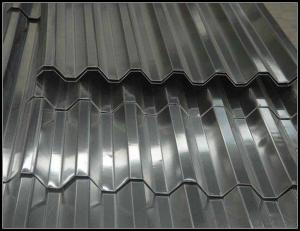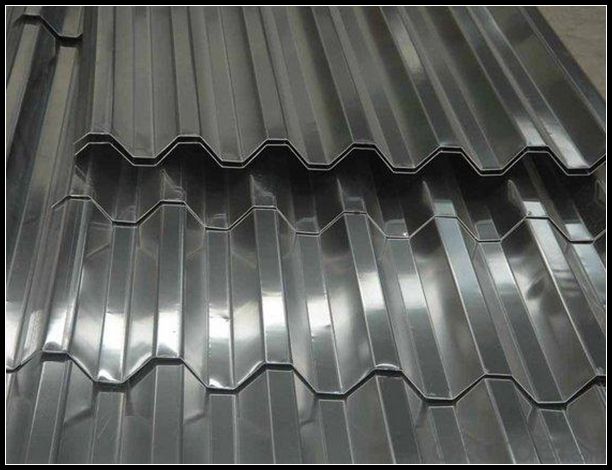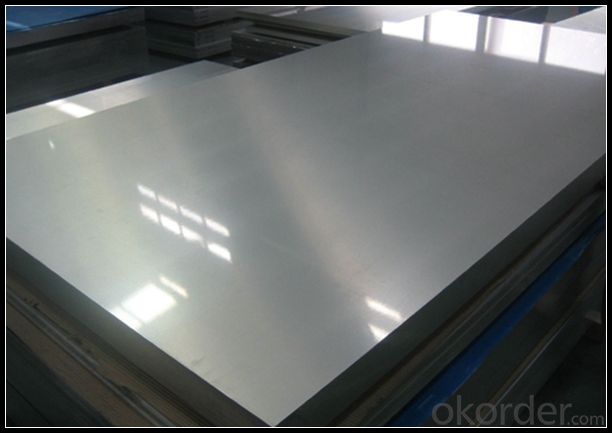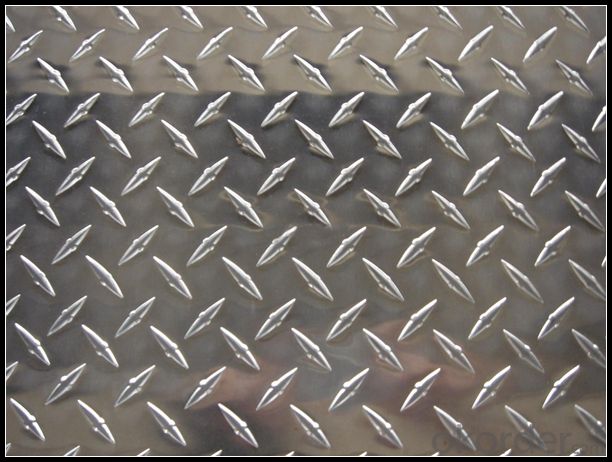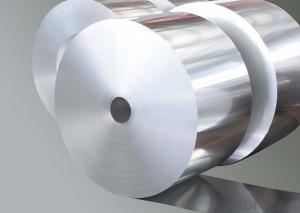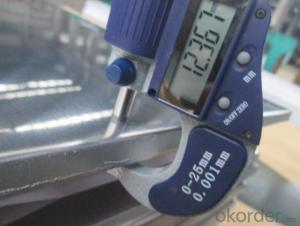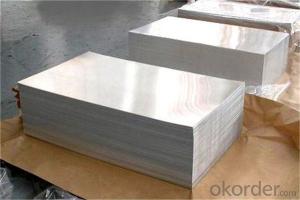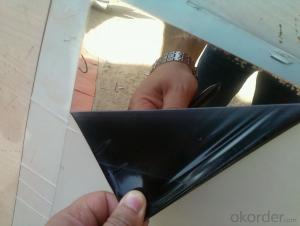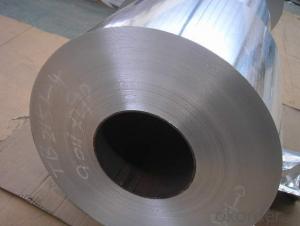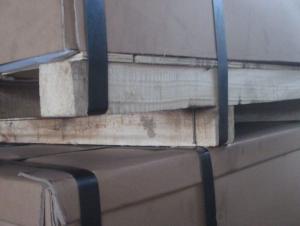Aluminum Foil Single Sheets - Best Quality Aluminum Mirror Sheet in China
- Loading Port:
- Shanghai
- Payment Terms:
- TT OR LC
- Min Order Qty:
- 5 m.t.
- Supply Capability:
- 10000 m.t./month
OKorder Service Pledge
OKorder Financial Service
You Might Also Like
Specification
1. Specification of Aluminum Mirror Sheet
Aluminum Coil/Sheet | |
Main Specification | |
Alloy | AA1xxx (AA1050, AA1060, AA1070, AA1100 etc.) |
AA3xxx (AA3003, AA3004, AA3005, AA3105 etc.) | |
AA5xxx, AA6XXX (AA5052,AA5083, AA5754, AA6061, AA6062 etc.) | |
AA8xxx(AA8011, AA8006 etc.) | |
Temper | H14,H16, H18, H22, H24, H26, H32,O/F, T4, T6, T651 |
Thickmess | 0.01mm-100mm |
Width | 30mm-1700mm |
Standard | GB/T 3880-2006/ASTM |
Special specification is available on customer's requirement | |
2. Application of Aluminum Mirror Sheet
(1).Interior: wall cladding, ceilings, bathrooms, kitchens and balconies, shutters, doors...
(2).Exterior: wall cladding, facades, roofing, canopies, tunnels,column covers , renovations...
(3).Advertisement: display platforms, signboards, fascia, shop fronts...
3. Feature of Aluminum Mirror Sheet
Surfact Quality :
Be free from Oil Stain, Dent, Inclusion, Scratches, Stain, Oxide Dicoloration, Breaks, Corrosion, Roll Marks, Dirt Streaks and other defect which will interfere with use,
Mechenical Property:
Chemical Composite and Mechanical Property
4. Certificate:
SGS and ROHS(if client request, paid by client), MTC(plant provided), Certificate of Origin(FORM A, FORM E, CO), Bureau Veritas and SGS (if client request, paid by client), CIQS certificate
5. Image of Aluminum Mirror Sheet

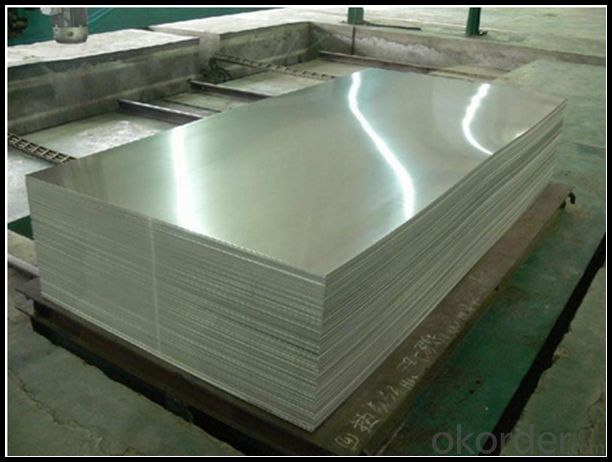
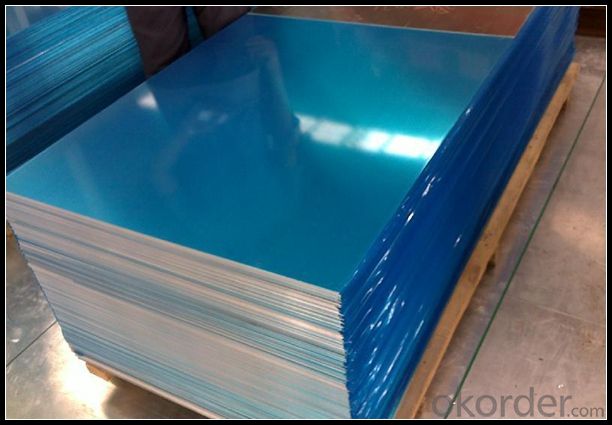
6. Package and shipping of Aluminum Mirror Sheet
First, plastic cloth with drying agent inside; Second, Pearl Wool ; Third, wooden cases with dry agent , fumigation wooden pallets, aluminum surface could cover blue PVC film
7. FAQ
1) What is the delivery time?
Dpends on actual order, around 20 to 35 days
2)What is the QC system:
We have QC staff of 20 persons and advanced equipment, each production is with MTC traced from Aluminum ingot lot.
3) What market do you mainly sell to?
Australia, America, Asia, Middle East, Western Europe, Africa etc
- Q: How do you join aluminum sheets together?
- To join aluminum sheets together, there are various methods available depending on the specific application and desired joint strength. The following techniques are commonly used: 1. Welding: Aluminum can be welded using gas tungsten arc welding (GTAW or TIG), gas metal arc welding (GMAW or MIG), or laser welding. These processes involve melting the aluminum at the joint and introducing a filler material to create a strong bond. Welding offers excellent strength and durability, but it requires skill and suitable equipment. 2. Riveting: Aluminum sheets can be fastened together using rivets. This technique involves drilling holes through the sheets and using a rivet gun to insert and deform a rivet, creating a secure joint. Riveting is a relatively simple and quick method, but its strength may not match that of welding. 3. Adhesive bonding: Industrial adhesive bonding is a popular method for joining aluminum sheets. Specialized adhesives formulated for aluminum bonding are applied to the surfaces, which then cure and form a strong bond. Adhesive bonding is advantageous as it evenly distributes stress and can join dissimilar materials. However, it may not be suitable for high-temperature or high-stress applications. 4. Mechanical fasteners: Aluminum sheets can be fastened together using screws, bolts, or nuts. This involves drilling holes and using fasteners to secure the sheets. Mechanical fasteners provide good strength and allow for disassembly if needed. However, they may require additional maintenance and can cause stress concentrations around the holes. 5. Clinching: Clinching is a cold joining method where aluminum sheets are pressed together using a punch and die. This process deforms the materials and creates a mechanical interlock, resulting in a strong joint. Clinching is a quick and cost-effective method, although it may not be suitable for thin or highly rigid sheets. Ultimately, the choice of joining method depends on factors such as the required strength, aesthetics, cost, and ease of fabrication. It is advisable to seek guidance from a qualified professional or follow specific guidelines to ensure a successful and reliable joint.
- Q: Are the aluminum sheets suitable for manufacturing electrical enclosures?
- Indeed, aluminum sheets prove to be a suitable material for the production of electrical enclosures. Within the manufacturing industry, aluminum is widely utilized due to its versatility and numerous advantages. To begin with, aluminum possesses a unique combination of lightweight properties and strength, making it an ideal choice for constructing enclosures that require durability without the burden of excessive weight. Its strength-to-weight ratio surpasses that of many other metals, allowing for the creation of sturdy enclosures without unnecessary bulkiness. Moreover, aluminum exhibits exceptional resistance to corrosion, a crucial attribute for electrical enclosures that may encounter various environmental conditions, such as moisture, humidity, or corrosive elements. The natural oxide layer present on aluminum acts as a protective barrier, ensuring the enclosures' longevity and reliability. Additionally, aluminum possesses excellent electrical conductivity, a vital characteristic for electrical enclosures. This property facilitates efficient dissipation of heat generated by electrical components, effectively preventing overheating and potential damage to the enclosed devices. Furthermore, aluminum is highly machinable and can be easily molded into different shapes and sizes. This inherent flexibility enables manufacturers to customize the enclosures according to specific requirements, ensuring a perfect fit for the intended electrical components. Finally, when considering cost-effectiveness, aluminum proves to be a more economical choice compared to other metals such as stainless steel or copper. It strikes a balance between affordability and performance, making it an attractive option for the manufacturing of electrical enclosures. In conclusion, the lightweight nature, strength, corrosion resistance, electrical conductivity, machinability, and cost-effectiveness of aluminum sheets make them a highly suitable material for the production of electrical enclosures.
- Q: This question asks about the various types of aluminum sheets that are suitable for use in exterior applications, specifically those that can withstand outdoor conditions.
- <p>Aluminum sheets used for exterior applications come in various types, each with specific properties to withstand weather and environmental conditions. These include: 1. Mill Finish Aluminum Sheets: These have a natural aluminum finish and are used for applications requiring a raw, industrial look. 2. Anodized Aluminum Sheets: These are aluminum sheets that have been treated to increase their resistance to corrosion and wear. 3. Painted Aluminum Sheets: These are coated with a layer of paint for added protection and aesthetic appeal. 4. Embossed Aluminum Sheets: These have a textured surface and are used for decorative purposes or to provide a non-slip surface. 5. Perforated Aluminum Sheets: These are aluminum sheets with holes punched through them, used for ventilation or decorative purposes. Each type is chosen based on the specific requirements of the exterior application, such as durability, aesthetics, and environmental resistance.</p>
- Q: Which kind of glue can bond two pieces of aluminum sheets?
- oxygen welding
- Q: Are the aluminum sheets suitable for manufacturing architectural ceiling panels?
- Indeed, architectural ceiling panels can be manufactured using aluminum sheets. Aluminum possesses durability, a lightweight nature, and corrosion resistance, rendering it a perfect material for architectural purposes. It can be effortlessly shaped and molded into diverse panel designs and sizes, granting flexibility in crafting distinctive ceiling designs. Furthermore, aluminum sheets come in various finishes and colors, enabling customization to satisfy specific design needs. In summary, aluminum sheets offer a cost-effective and visually delightful solution for the production of architectural ceiling panels.
- Q: Can aluminum sheets be used for insulation?
- Yes, aluminum sheets can be used for insulation. Aluminum is a good conductor of heat and electricity, so it can effectively reflect and block thermal energy. Aluminum foil, for example, is commonly used as a radiant barrier in insulation systems. It helps to prevent heat transfer by reflecting radiant heat away from the building, thus reducing the amount of heat that enters or escapes through the insulated areas. Additionally, aluminum sheets can also be used as a vapor barrier to prevent moisture from penetrating into the insulation, which helps to maintain its effectiveness. Overall, aluminum sheets can be a cost-effective and efficient option for insulation purposes.
- Q: Can aluminum sheet be used for packaging applications?
- Certainly! Packaging applications can definitely make use of aluminum sheet. The packaging industry widely employs aluminum due to its exceptional qualities. Its lightweight nature, strength, durability, and ability to be molded make it perfect for packaging diverse products. Aluminum sheets can be easily shaped into different forms and sizes, offering tailored packaging solutions. Moreover, aluminum boasts excellent barrier properties, guarding against moisture, gases, and light, which helps maintain the freshness and quality of packaged goods. Additionally, aluminum is non-toxic and can be effortlessly recycled, making it an environmentally friendly choice for packaging applications. In conclusion, aluminum sheet is a versatile and dependable material for packaging various items, such as food, beverages, pharmaceuticals, cosmetics, and more.
- Q: What are the common surface finishes for aluminum sheets?
- The common surface finishes for aluminum sheets include mill finish, brushed finish, anodized finish, and powder-coated finish.
- Q: Hi,I need some interesting facts about AluminiumLike who found/discovered it, and how, or/and history of it. Recycling it, or does it have effects on the environment,Thanks if you can help,Thank you thank you thank you!Xx
- Aluminium is remarkable for the metal's low density and for its ability to resist corrosion due to the phenomenon of passivation. Structural components made from aluminium and its alloys are vital to the aerospace industry and are very important in other areas of transportation and building. Its reactive nature makes it useful as a catalyst or additive in chemical mixtures, including ammonium nitrate explosives, to enhance blast power. all the ifo u need isat the link below
- Q: a dream I had where the carbon element was extracted from aluminum and ploished it became transparent, it was bendable and you could puncher it with out breaking it ?
- Aluminium is an element! Elements are pure substances, therefore aluminium doesn't contain any carbon. What do you mean?
Send your message to us
Aluminum Foil Single Sheets - Best Quality Aluminum Mirror Sheet in China
- Loading Port:
- Shanghai
- Payment Terms:
- TT OR LC
- Min Order Qty:
- 5 m.t.
- Supply Capability:
- 10000 m.t./month
OKorder Service Pledge
OKorder Financial Service
Similar products
Hot products
Hot Searches
Related keywords
